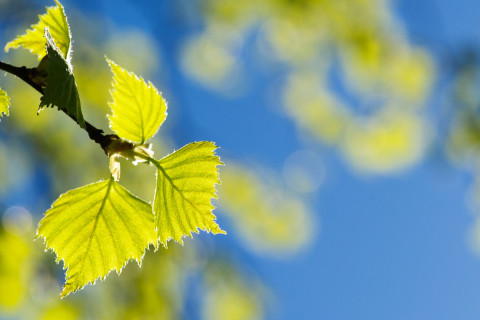The doctoral dissertation in the field of Biology will be examined at the Faculty of Science, Forestry and Technology, Joensuu Campus and online.
What is the topic of your doctoral research? Why is it important to study the topic?
This thesis examined the ecophysiological differences and similarities in growth, biomass-allocation and photosynthesis-related traits among silver birch provenances originating from several latitudes across Finland. Boreal forests are globally one of the major carbon sinks, and therefore the carbon assimilation and growth of trees is currently of very high interest. As the name implies, ecophysiology studies how the ecological and physiological traits of a plant affect each other. For example, functional traits dependent on leaf structure, such as the capacity to photosynthesize at different temperatures and in different lighting conditions, have an impact on how well plants can acclimate and adapt to climate change. On the other hand, the acclimation and selection pressure caused by climate change affects plant function and traits. This research reviews these kinds of complex interrelated traits-sets in a climate change context. Silver birches were studied with field and growth chamber trials. In the experiments, the southernmost provenance (Loppi) represented the warm, south boreal southern Finland, while the northernmost provenance (Kittilä) is from the very edge of silver birch distribution and represented the north boreal forest vegetation zone. Understanding such geographical variation is important, as different tree provenances may face climate change from very different starting positions. Of interest were differences among silver birches in the current climate, in addition to which glimpses of the future were attained by measuring photosynthetic temperature and light responses and by growing the birches in southern and northern photoperiods. The interactive effects of warming and the photoperiods prevalent at different latitudes have not been studied much, especially in a northern context.
What are the key findings or observations of your doctoral research?
Northern Finnish silver birch provenances were clearly distinct from southern ones in many traits. Northern provenances had higher leaf-area –based capacity to photosynthesize, as they were observed to have higher stomatal conductance despite a lower stomatal density. Northern provenances also had a higher relative height growth rate. However, in the north, carbon assimilation and thus growth do not operate in a similar environment as in the south. The short and cold growing period, heavy snow loads and the polar day of the north set strict limits on how useful it is for a plant to invest in above or below-ground biomass. Indeed, northern silver birches were found to invest more heavily in roots than in the stem, branches or leaves. These traits observed in the northern provenances were jointly called with a newly coined name, the ‘polar day syndrome’. Coining this term was intended to encourage further research to account for the assumed benefit these traits provide in a situation where photosynthesis and growth need to be maximized in demanding northern conditions. A major unanswered question has been the capacity of northern trees to acclimate and adapt to climate change. Different tree provenances have been thought to differ in this capacity, but making predictions has been difficult as many of the physiological differences among provenances have been unknown. Based on this research silver birch is likely able to plastically acclimate several traits to new environmental conditions. This is because many traits were observed to be also equal among the provenances, which was interpreted as capacity to adjust to prevalent conditions. Despite higher stomatal conductance in northern provenances, the temperature and light responses of the gas exchange happening through the stomata did not differ between northern and southern birches. For example, the optimum temperature of gas exchange did not differ between geographically distant provenances when grown in similar conditions. In addition, leaf longevity (age), leaf mass per area and chlorophyll content did not differ among provenances.
How can the results of your doctoral research be utilised in practice?
Silver birch is a model organism, and its genetics and breeding prospects are well known. A lot of variation is known to exist within provenances, but the among-provenance differences in natural populations have been more unknown. Silver birch is a pioneer species with great potential as a carbon accumulator plant, but to better understand the utilization and the future of the species the among-provenance differences in traits related to carbon assimilation and growth must be known. Transplanting plants from a specific latitude brings with it a set of traits, which should be accounted for when transfers are being planned especially in a changing climate. For example, transferring from northern areas of continuous light to southern areas of non-continuous light means that the apparently good capacity for photosynthesis and high relative growth rate of northern silver birches are useless for wood production, as these trees have earlier growth cessation and different biomass-allocation than southern ones.
What are the key research methods and materials used in your doctoral research?
One of the setups in this research was a so-called common garden transplantation experiment, founded by the plant ecophysiology group of the University of Eastern Finland. This experiment used plants clonally reproduced from mother trees of several silver birch provenances across Finnish latitudes. Two growth chamber experiments were consecutively carried out, in which southern and northern birches were compared to each other more comprehensively in controlled conditions and in which the provenances’ responses to photoperiod were compared. Research methods included various measurements of photosynthesis (gas exchange and chlorophyll fluorescence), traditional growth measurements and optical measurements of chlorophyll content. Assistance was provided by the personnel of the Natural Resources Institute of Finland, the botanical garden of Joensuu and the University of Eastern Finland. This research utilized the equipment of the Spectromics-laboratory of the University of Eastern Finland and was part of the Academy of Finland flagship programme Photonics Research and Innovation (PREIN).
The doctoral dissertation of Antti Tenkanen, MSc, entitled Latitude-related variation in silver birch provenances in a changing climate; Growth, biomass allocation and photosynthesis-associated leaf-traits in the field and in growth chamber trials will be examined at the Faculty of Science, Forestry and Technology, Joensuu Campus. The opponent will be Docent Esa Tyystjärvi, University of Turku, and the custos will be University Lecturer Sari Kontunen-Soppela, University of Eastern Finland. Language of the public defence is Finnish.
For more information, please contact:
Antti Tenkanen, [email protected], tel. +358 40 841 7758
- Public examination online (in Finnish)
- Dissertation (PDF)
- Photo available for download





